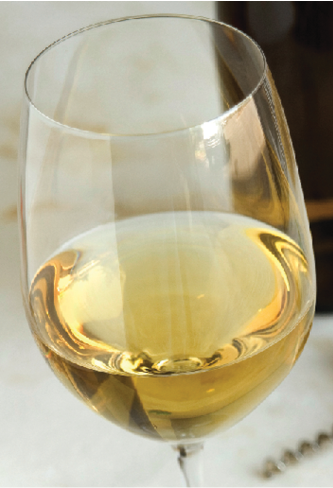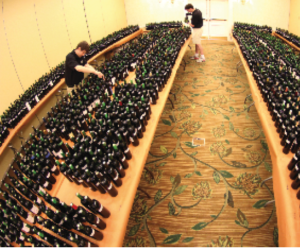 In spite of their long history as wine preservatives dating to the days of the Romans, sulfites can receive a bad rap. Many suspect that sulfites cause headaches or believe that any preservative is harmful, and so, there is a strong push to eliminate — or at least reduce — the use of sulfites and any additives perceived not to be “natural.”
In spite of their long history as wine preservatives dating to the days of the Romans, sulfites can receive a bad rap. Many suspect that sulfites cause headaches or believe that any preservative is harmful, and so, there is a strong push to eliminate — or at least reduce — the use of sulfites and any additives perceived not to be “natural.”
Can more natural wines be made without sulfites and additives, and such mechanical interventions as filtration? Yes, if grapes are harvested and delivered in perfect condition without rot and at perfect pH, TA and Brix, though one would still need to contend with indigenous yeasts that will get to work in earnest to cause flaws or spoilage if uncontrolled. Grapes and fresh juice are never perfect and therefore require special handling to minimize the risks of oxidation, microbial spoilage and instabilities due to naturally occurring substances that can wreak havoc under favorable conditions.
Here, we will propose a list of additives, processing aids and techniques for crafting superior wines with more aromatic complexity, more flavor and with longer aging potential while reducing the use of sulfites. Completely eliminating sulfites from any home winemaking protocol is simply too risky.
Many of the concepts and techniques presented here have been adapted from the work of Arnaud Immélé, renowned Alsatian enologist and advocate of “bio” and sulfite-free wines.
Let’s review some basic chemistry of wine oxidation to understand the tools and techniques we’ll be proposing.
Chemistry of oxidation
As grapes are crushed, naturally occurring polyphenoloxidase (PPO) enzymes start oxidizing phenolic compounds extracted from the juice and skins causing those compounds to turn a brownish color. Sulfur dioxide (SO2) is added to inactivate PPOs and prevent this oxidation. At the end of fermentation, PPOs are inactive and no longer a concern. Polyphenols (tannins and anthocyanins) in reds then consume oxygen, particularly in the absence of SO2, and slowly brown during aging giving reds their characteristic brownish hues. Excessive oxygen ingress will accelerate these effects and reduce the wine’s aging potential. Once polyphenols have been exhausted — if wine is aged for too long — the wine is no longer protected and begins its oxidative decline. Whites have very little polyphenols and are thus much more susceptible to oxidation.
Laccase enzymes are also found in rotten grapes affected by B. cinerea mold, which can further oxidize phenols; however, laccase is more difficult to control as it is more resistant to SO2 and its oxidative effects are much greater than PPOs. Consequently, laccase can carry into the wine and linger for much longer to cause problems downstream; therefore, it is critical to remove any rotten fruit from grapes if you want to reduce sulfites in your winemaking.
Ethanol can also oxidize to acetaldehyde and impart a Sherry-like smell, and acetaldehyde can then bind with polyphenols to effect color changes. In the presence of spoilage Acetobacter, ethanol can oxidize to acetic acid and both can be esterified into powerful ethyl acetate (nail varnish smell) odorants. And so it critical to protect wine from oxygen from the end of fermentation to (and during) bottling.
And it will be even more important to monitor pH throughout winemaking as micro-organisms thrive at high pH, many of which can surreptitiously manifest their destructive power in the absence of oxygen. Be particularly prudent with rogue lactic acid bacteria that can produce excessive diacetyl and impart strong off aromas and flavors, and Brettanomyces yeast, if you work with oak barrels, which can produce unpleasant barnyard-like smells.
Additives and processing aids
Ascorbic acid (Vitamin C), which occurs naturally in the order of 50–80 mg/L (ref 1) in grapes, will be a key additive owing to its ability to quickly consume dissolved oxygen (DO). And for this reason, it is only recommended in low polyphenol wines — mainly young whites, not reds or full-bodied whites such as oaked Chardonnay. But you’ll recall that its effect is transitory and, therefore, it must be used judiciously and diligently particularly where sulfites are not used.
Ascorbic acid quickly fixes to DO and converts to dehydroascorbic acid (a weak acid) and hydrogen peroxide (H2O2), a powerful oxidizer, hence why it must be used with SO2 — to allow sulfite ions to sequester H2O2. H2O2 effects are mainly of concern in wine where it reacts with ethanol to produce acetaldehyde. Following oxidation, ascorbic acid is exhausted and serves no further function. It is not recommended for reds since both ascorbic acid and H2O2 can bind to anthocyanins and cause bleaching (color loss).
Total ascorbic acid additions should not exceed 250 mg/L (approximately 1 g per gallon). A simple method from Immélé to determine how much ascorbic acid to add is to multiply the required amount of SO2 by 4.4. For example, if you require 30 mg/L of free SO2, add 132 mg/L of ascorbic acid.
Gallotannins are enological gall nut tannins having high antioxidant capacity and minimal impact on bitterness and astringency. Gallotannins are indispensable in warding off oxidation, especially in low-phenol reds, and are recommended as must additives to inhibit enzymatic polyphenol oxidation. But be careful! Gallotannins are more reactive to oxygen than aromatic (odoriferous) compounds, which need oxygen to express their full aromatic potential, and are therefore not recommended for varietals such as Muscats and Gewürztraminer.
Pectinase enzymes aid in breaking down pectins that could otherwise cause a haze or cloudiness in wine; they can also be used at the crusher to increase the yield of free-run wine.
Glucanase enzymes aid in breaking down colloids and glucans to improve pressing and color extraction. Both types of enzymes improve fining and filterability.
Only use cultured Saccharomyces cerevisiae yeast for fermentation. Never rely on indigenous yeast as it all becomes a game of Russian roulette — wine will be at great risk of developing faults or spoilage. Indigenous yeast will cause competitive stress on S. cerevisiae yeast once these kick in and take over fermentation. So it will be best to prepare a yeast starter that can quickly jump-start fermentation and minimize the effects of indigenous yeast.
If you wish to draw other desirable aromas and flavors from non-Saccharomyces yeast without compromising the Saccharomyces fermentation, perform a sequential fermentation using Torulaspora delbrueckii yeast if you can source it; this technique is becoming popular in commercial winemaking.
Supplement yeast with yeast nutrients containing thiamin (Vitamin B1) to ensure a healthy fermentation and to reduce sulfurous by-products. Thiamin limits fermentation by-products that would otherwise bind (reduce) SO2, and so, less free SO2 is required. The use of nutrients should be standard practice and are essential where grapes are affected by rot.
For malolactic fermentation (MLF), here too only use cultured Oenococcus oeni bacteria.
In all cases, ferment wine to dryness and complete conversion of malic to lactic acid where MLF is desired. Since wine will have reduced protection from SO2 against latent yeast and bacteria, any residual sugar or malic acid becomes a source of food for these spoilage micro-organisms.
Gelatin is a processing aid for fining tannic red wine given its affinity to bind with polyphenols. In whites it must be used with silica gel to avoid over-fining; however, it is recommended for many white varietals where the must will be subjected to hyperoxidation. Alternatively, egg whites can be used in reds, particularly where harsh tannins need to be rounded out; they have minimal impact on color.
Lysozyme is an enzyme isolated from egg whites and is used in wine to suppress spoilage bacteria; it is not effective against Acetobacter or Brettanomyces. Unlike SO2 which is less effective at higher pH, lysozyme is most effective at higher pH when spoilage bacteria thrive the most. It does not replace the use of sulfite but it can be used concurrently as a strategy to reduce the amount of SO2 for microbial stability. Burgundian winemakers are known to use lysozyme concurrently with egg whites following MLF purposely for reducing sulfites.
Sulfites will remain part of winemakers’ toolbox as, more often than not, these will be required to address some fault or problem. Sulfites should be particularly avoided in winemaking from rotten grapes; these have high polyphenol content, and sulfite would exacerbate phenolic extraction making the wine overly bitter and astringent.
Potassium sorbate, used to inhibit a renewed fermentation in non-dry (>0.2% residual sugar) wines, is seldom used in natural or commercial winemaking as wine is usually sterile filtered for microbial stability. Since complete sterile filtration is not possible in a home winery, potassium sorbate is the
only alternative.
Processing techniques
Hyperoxidation (hyperox) is a white winemaking technique whereby the must is subjected to great amounts of oxygen to hasten enzymatic oxidation of bitter-tasting, astringent polyphenols to increase the resulting wine’s resistance to oxidative effects during post-fermentation processing and aging, and to improve the wine’s sensory profile. The technique causes the must to temporarily turn very quickly to a dark brown color.
Micro-oxygenation (micro-ox) is a post-fermentation red winemaking technique used to inject miniscule amounts of oxygen in controlled fashion in conjunction with oak adjuncts to bind polyphenols and allow red wine to develop its full potential of aromas and ageability. It also reduces green, herbaceous aromas much more rapidly than in conventional barrel aging in those green-prone Cabernet varieties. Micro-ox can be easily implemented using a gas diffuser and an oxygen tank equipped with a regulator.
Filtration is a requirement in making natural wines to remove any latent yeast or bacteria before bottling. Sterile filtration and bottling are required to ensure microbial stability — these processes are not possible using home winemaking equipment. Yeast cells are greater than 1.2 μm and most spoilage bacteria are greater than 0.65 μm, and so filtration using fine pads with an absolute rating of 0.65 μm or less is needed. Home winemaking filtration equipment use pads with a nominal rating, meaning that smaller and larger particles will pass through. My recommendation is to filter down to 0.5 μm (nominal), which can be accomplished with #3 pads or those labeled “fine.”
Bottling is the most critical step as it is a high-oxygen ingress process that must be carried out swiftly under highly sanitary conditions. And don’t skimp on corks. Seek out the best natural or technical (agglomerated) corks; poor closures have a high oxygen transfer rate (OTR) that will compromise wine quality and aging potential. Avoid cheap synthetic corks — they have one of the highest OTR of closures.
Can natural wines age?
Immélé asserts based on his extensive experience that sulfite-free wines have proven to be aromatically superior to their sulfited counterparts. He argues that “once free SO2 in a sulfited wine is down to zero [through binding], it is in the same situation as a wine to which no sulfite has been added; however, the sulfited wine would not have been made [according to the winemaking mindset and techniques to ward off oxidation.]”






